Thursday, May 27, 2010
Monday, May 24, 2010
Pain Management
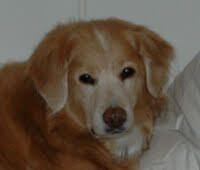 One of the many things I am very proud to say we do well at Friendship is attend to our patients’ pain. When I had Westin spayed in 1996 I was given the option to provide her with pain medication at an addition cost to the procedure. I was then and fourteen years later still am appalled that someone would not consider pain medication to be essential with intra-abdominal surgery. It seems like that was a long time ago but just last month I encountered a dog that had surgery at another clinic and was not sent home with any pain medication.
One of the many things I am very proud to say we do well at Friendship is attend to our patients’ pain. When I had Westin spayed in 1996 I was given the option to provide her with pain medication at an addition cost to the procedure. I was then and fourteen years later still am appalled that someone would not consider pain medication to be essential with intra-abdominal surgery. It seems like that was a long time ago but just last month I encountered a dog that had surgery at another clinic and was not sent home with any pain medication.It was long thought in veterinary medicine that we did not need to address pain in our patients’ because “animals feel less pain than humans”, “pain is beneficial because it limits activity” and “analgesia hides clinical deterioration”. These rationales are now known to be false and in fact pain can take a tremendous toll on our patients.
Without providing proper pain management we put our patients at risk for delayed wound healing, increased risk of sepsis, prolonged convalescence, increased metabolic demand and cardiovascular stress. Studies in humans suggest that improperly controlled acute pain may precipitate a chronic pain syndrome that can be very difficult to control. Above all else, we have an ethical obligation to provide humane care to our patients.
Friendship provides our patients with multi-modal pain management before, during and after a painful event be it surgery, trauma or illness. We are also aggressive with controlling chronic pain such as that seen with arthritis. This consists of opioid drugs, non-steroidal anti-inflammatories, local anesthetic, constant rate infusions and the therapeutic K-laser.
Animals are very good at hiding pain and it is up to both veterinarians and owners to make sure that they are kept as comfortable as possible.
Thursday, May 13, 2010
Tuesday, May 11, 2010
Brighton and the new baby
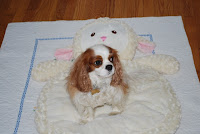
Our goal was to anticipate the changes the new baby would make to Brighton’s schedule, and then start introducing those changes five or six months before the baby was due. That way, Brighton would have plenty of time to get accustomed to his new routine, and there wouldn’t be so much to adjust to once Tyler arrived on the scene.
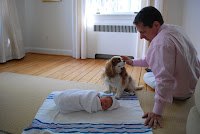
Brighton's owners set up a schedule that they hoped to maintain once baby Tyler arrived. Each day included at least ten minutes of uninterrupted "Brighton time" that would happen no matter what was going on with the baby.

Whitney created a beautiful nursery in preparation for baby Tyler. She and John always left the nursery door open so Brighton could explore the area and get used to the unfamiliar smells of baby powder and diapers. Though he was encouraged to investigate, Brighton was never allowed to sleep on any of the baby's furniture or belongings, because these would be off-limits once Tyler was home.
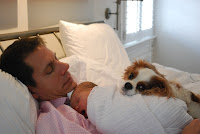
Once Tyler was born but still in the hospital with her mom, John brought home some of the clothes the baby had worn and left these around the house for Brighton to smell. This gave Brighton a chance to get acquainted with all the smells of a newborn baby, so he wouldn’t besurprised when Tyler came home.
When Whitney and Tyler were released from the hospital, John waited outside their home with the baby while Whitney went in to greet Brighton. Once Brighton calmed down from the excitement of not seeing Whitney for three days, John and Whitney set up a formal meeting of baby and dog. Whitney sat on the couch with Tyler, and John brought Brighton in on a leash. Whitney and John praised and petted Brighton while he approached and sniffed Tyler.
Whitney and John are lucky: since Brighton is an exceptionally well-behaved and sweet dog, he accepted his new sister without missing a beat.
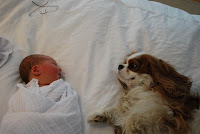
But not all dogs are as laid-back as Brighton. If a dog shows any signs of aggression, excitement or excessive interest in a baby, the dog should be kept on a leash at all times when the baby is present. When only one adult is home, the dog should be kept in a separate room, without any access to the baby. Remember that even a non-aggressive dog may become overly exuberant and cause injury by jumping up on a baby.
A new baby is a big change in any household, but with thoughtful planning the transition can be made as smooth as possible for your furry family members.
Tuesday, May 4, 2010
Canine Cancer Awareness
 As a pet owner who lost a dog to not one, but three types of cancer--lymphoma, melanoma and hemangiosarcoma--I know firsthand how devastating, confusing and overwhelming this diagnosis can be. The only possible shred of good news is that you have the warm, caring embrace of the Oncology Department at Friendship available to you.
As a pet owner who lost a dog to not one, but three types of cancer--lymphoma, melanoma and hemangiosarcoma--I know firsthand how devastating, confusing and overwhelming this diagnosis can be. The only possible shred of good news is that you have the warm, caring embrace of the Oncology Department at Friendship available to you.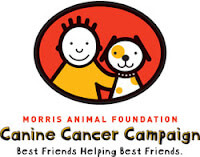
Though most cancers in companion animals are, unfortunately, not yet curable, many are now treatable thanks to devoted doctors like Chand Khanna and organizations like the Morris Animal Foundation. We are making great advances in managing cancer in our beloved pets and one day we will find a cure. I treasured each day I had with Westin and consider myself blessed that she had Dr. Khanna and the oncology service at Friendship looking after her.







